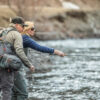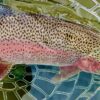Synopsis
Warmer weather has finally become a pattern in the Sun Valley area, and what was good fishing is becoming great fishing. A variety of techniques will all take fish.
Dry fly enthusiasts need only wait until the day begins to warm, sometime around 11:00 a.m. The Midge dry fly fishing can stay good until around 4:00 p.m. The action seems to peek around 1:00 or 2:00 o’clock. Griffiths Gnats, last summers leftover Trico patterns, tiny Parachute Adams, will all take fish, but you will want some trailing shuck patterns as well. This fly pattern is always listed in the winter report as the trout that are feeding on Midge Duns, are constantly seeing them buzz, and zip across the surface, making them elusive and often too much trouble to rise for. So when a trout sees the Midge that cannot or has not escaped it’s nymphal shuck, that means easy pickens’ on a bug that has no ability to fly away and avoid the inevitable meal it is about to become. The down side to fishing this pattern is keeping it visible, as most lay flat on the water. This is why we always suggest fishing it in tandem with a fly that silhouettes well against the silvery glare of the surface in the winter, like a Griffiths Gnat. No two flies seem to work as symbiotically together as these two.
If you want to start fishing earlier in the day, or just want to search below the surface for those fish uninterested in the Midge dry, there are a lot of fish waiting on the bottom for a nice easy to grab nymph. A variety of patterns will work, with Brassies and Hares Ears being amongst the most effective. Fly choice may not be quite as important as the way you fish a nymph in the winter. It is imperative that your drift is slow and as close to the fish on the bottom as you can get it without hanging up the fly. Typically over a gravel bottom, you should almost have that fly dragging along the rocks. If you are prospecting a riffle the fly should bump enough to knock your indicator around some, and even pull it under occasionally. When it happens just set the hook, every now and again, the bottom will pull back and you know your in business! Remember, when the Midge activity is on, the fish will often move shallower than one would imagine they do in the winter. To manage where your fly is in the waters stratum, pay careful attention to the length of your tippets and leaders and where you place your strike indicator. (Do not keep it up high on the heavy leader section.) Be even more aware of how you mend your line. Often the best slow drifts are achieved by standing across and above your target and letting the fly drift into the hot spot by keeping all the mended line up stream of the indicator and feeding a little line down stream behind it.
Big fish like big food. Streamer fishing is the best way to find out how big the fish in most rivers get. Our area rivers are no exception. There are some fish that are so preoccupied with eating other fish, that they barely notice the emergence of the Midge in winter. With the abundance of Sculpin in our area, even fish that aren’t looking to eat another fish will, when they see an opportunity to nab one of these ugly little baitfish. This means even the trophy hunting fly angler with a streamer is going to also catch good numbers of fish, and even a few that may shock you by the fact they will eat a streamer that is only 2/3 smaller than themselves! Needless to say our local Rainbows are extremely aggressive toward the Sculpin when they see it.
Finally, with Mach approaching and the spring spawning urge giving the trout a need to fatten up coupled with the seasons biggest Midge hatches, the river is definitely turning from good to great! The fact that we have these March like conditions in February is to good to pass up, so if the hill is getting a bit crowded or the snow is vanishing too fast, take solace in the fact that we are on the cusp of the seasons best fishing!



